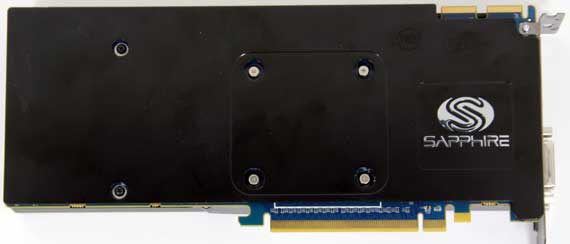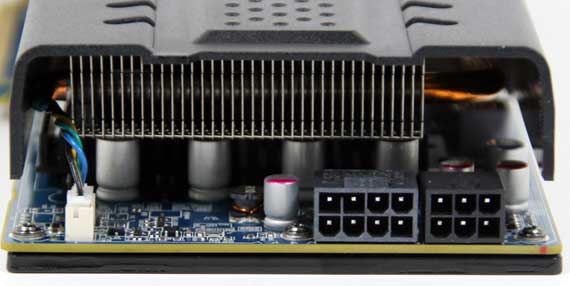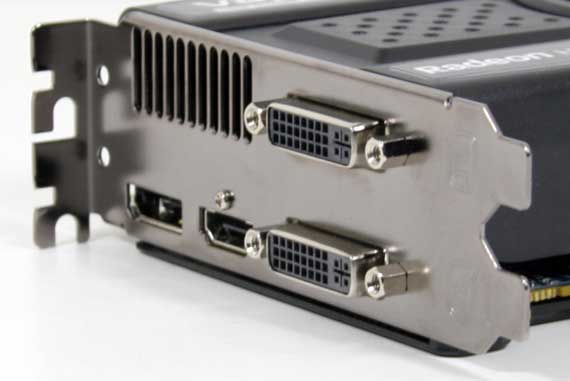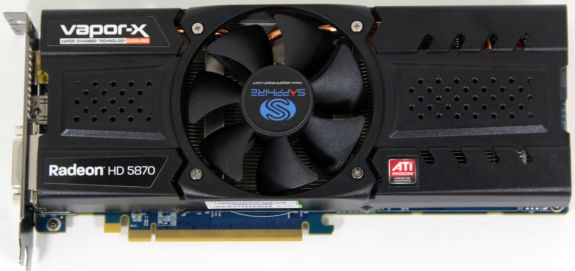Overclocked: Our Custom Radeon HD 5870 Roundup
by Ryan Smith on May 19, 2010 11:53 AM ESTSapphire Radeon HD 5870 Toxic 2GB
We’ll start things off with Sapphire’s Radeon HD 5870 Toxic. The 5870 Toxic 2GB is Sapphire’s shot at a custom 2GB Radeon HD 5870, forgoing AMD’s 5870E6 design for a design of their own. In this case Sapphire has ditched the Eyefinity 6 concept entirely, opting to build a card closer to a regular 5870 with 2GB of RAM. The result is a card that’s best described as a 2GB 5870, rather than a 5870E6.
The Toxic gets Sapphire’s customary touch, equipping the card with one of their famous Vapor-X coolers, the cornerstone of which is the use of a vapor chamber in the cooling assembly’s baseplate. The entire assembly is a card-sized aluminum heatsink connected to the baseplate by 3 heatpipes, with a 92mm fan in the center. Meanwhile the back of the card has a plate on it to serve double-duty as both a decoration and as a heatsink for the 8 128MB GDDR5 RAM modules on the back of the PCB. As with their other Vapor-X cooler products, the Vapor-X cooler on the Toxic is a partially covered design that blows air towards both the front and the rear of the card, so you’ll need a well-ventilated case for this card.

Moving on to the PCB, as with everything else this is a custom Sapphire design, a new design necessary to fit the extra 1GB of RAM. The card is 10.15” in length, making it shorter than the reference 5870. Unfortunately Sapphire also kept up their tradition of putting the PCIe power sockets on the rear of the card instead of the top, so it’s really 10.15” plus whatever room you need to maneuver your power cords. Speaking of which, since this is a 2GB 5870, the 5870 Toxic 2GB requires both 8pin and 6pin PCIe power to operate.

For component selection, Sapphire has decided to focus on their use of chokes and capacitors. Once again we see Sapphire’s grooved “Black Diamond” solid state chokes, and all of their capacitors are solid capacitors. As is the case with the rest of the cards in this roundup, this is as much a technical matter as it is a marketing matter: the reference 5870 design already uses solid state chokes and solid capacitors. So the difference comes down to component selection, with Sapphire using their higher quality chokes.
Sapphire is once again targeting the factory overclock market with the Toxic, shipping the card with a core clock of 925MHz and a memory clock of 1.225GHz (4.9GHz effective) – 75MHz and 100MHz faster than the stock 5870’s core and memory respectively. Since Sapphire isn’t targeting overclockers with this card it should come as no surprise that there’s little in the way of overclocking features for it. There is a generous overdrive limit of 1000/1500 for the card, but as it’s using Sapphire’s unprogrammable VRMs, there’s no way to change the GPU voltage. Making up for that is the card’s slightly higher default core voltage of 1.2v, necessary to drive the card’s higher core clock.

The included materials are also sparse: drivers, AnySim HD, power adapters, a VGA dongle, a CF bridge, and a generic multilingual manual.
Since this is not an Eyefinity 6 edition card, the port configuration is AMD’s standard Eyefinity configuration: 2xDVI, 1x DP, and 1x HDMI. The 2GB of RAM should also be of some help when it comes to Eyefinity, however as we saw in our 5870E6 review it’s limited at best.

The retail price of the card is around $500 – we briefly saw it at $489 before it went out of stock. Compared to the other cards in this roundup, the Toxic is going to be the hardest to find, as it’s currently out of stock everywhere we’ve checked. When in stock however, it’s priced close enough to the 5870E6 that they’re substitute products, so if you’re willing to give up 3 mini-DisplayPorts, you can get a factory overclocked 5870 instead.











43 Comments
View All Comments
bobsmith1492 - Wednesday, May 19, 2010 - link
As an electrical engineer, I wouldn't want to buy a card that is clocked so close to it usable limit. It's just begging for premature failures, especially at such high temperatures. A few months of dust build up and these cards will be pushing 120C, typically the level where components' lifespans are drastically reduced. I hope I'm wrong but I can't see video cards pushing much more horsepower without some serious form factor modifications.The0ne - Wednesday, May 19, 2010 - link
Nope, most enthusiasts believe their system will run free of dirt and grime for years and years and temperatures will stay the same. Once a part is tainted it becomes harder and harder to have it stay cleaned :) Take CPU fan for example hahahaiamezza - Thursday, May 20, 2010 - link
Old toothbrushes work brilliantly for cleaning dusty fans and heatsinks - to a 'good as new' state ;)Folterknecht - Wednesday, May 19, 2010 - link
Hi Ryan!What BIOS did your GB HD5870 use? There are two availeble "F2" and "F3". From discussions in the german GB-Support-Forum regarding GB HD 5850 OC, which is using the same cooler as far as I can tell, new BIOS-Versions were created to deal with some issues including noise.
There have been many angry posts, because GB advertised this cooler as "SUPER SILENT"!
If your test sample used "F2" an update to "F3" and eventual changes in idle characteristics would be interesting, if the test sample is still available.
Thanks for this interesting review
Folterknecht
cactusdog - Wednesday, May 19, 2010 - link
Gigabyte cant make a decent OC card. Just like their 4870 with the one speed noisy zalman fan and no fan adjustment. They just dont get it.I had high hopes for this new 5870 version but looks like they screwed up again. Apparently they released the card with one clock mode (flat out) no 2D clocks, no UVD clocks, just max clocks. As the previous poster said ,maybe the card in this review has the original bios.
Ryan Smith - Wednesday, May 19, 2010 - link
We're using the F3 BIOS.NinjaGnome - Wednesday, May 19, 2010 - link
I wish they would offer a card that either included a waterblock or came with no heatsink at all so the user can choose a waterblock or aftermarket cooler. I dont want to pay for an expensive oc version just to throw the block away so I can throw a waterblock on it.sirizak - Wednesday, May 19, 2010 - link
Here you go: http://www.powercolor.com/us/products_features.asp...Also if you want to add aftermarket cooling I would suggest buying a reference card (with the full shroud, fan at the rear and AMD printed above the PCIe Connnector) most aftermarket cooler manufacturers are only supporting the reference design.
sirizak - Wednesday, May 19, 2010 - link
Something I think this review missed was VRM cooling on these non-reference cards, the reference HD 5870 provides superior VRM cooling compared to most non-reference cards and allows for Voltage Control. I have managed 950Mhz Core Stable on my reference card without adding any voltage.I would have loved to see some VRM temps for each card under load, and perhaps a description of the type of VRM cooling they are offering.
Other than that great review, I was tossing up about the MSI and Gigabyte when I was purchasing so I found this really interesting, if a little late for my decision making :)
Ryan Smith - Thursday, May 20, 2010 - link
Unfortunately none of these cards are using VRMs that our existing tools can read temperatures from. This was particularly frustrating with the Gigabyte card, as we could see it throttling but couldn't see the temperature that was triggering it.